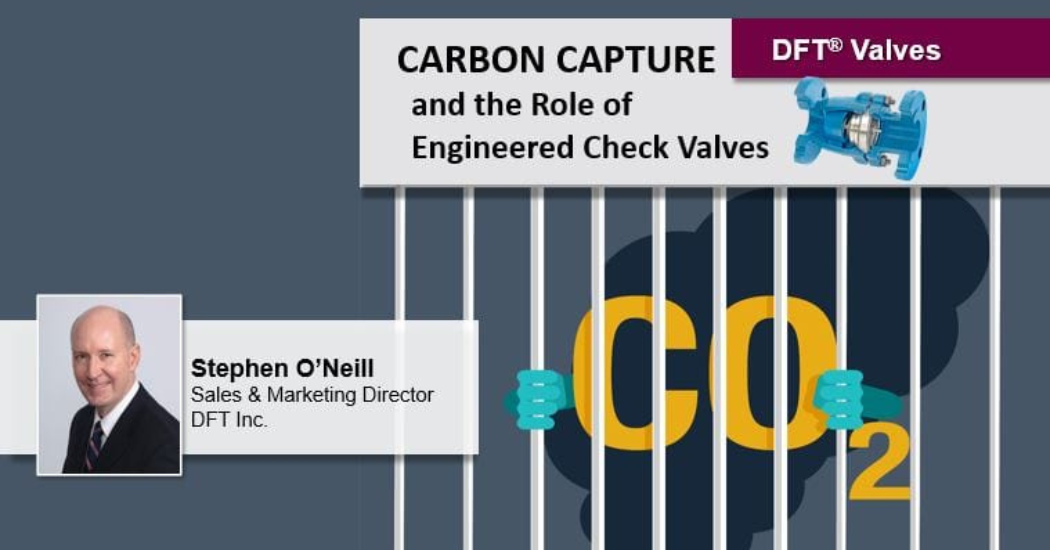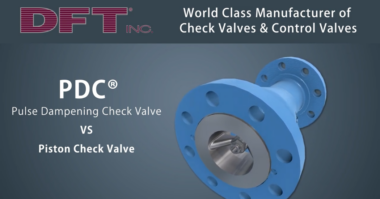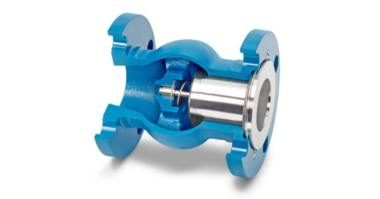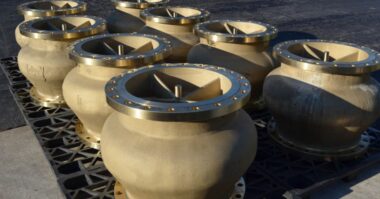As a follow-up from DFT’s webinar “Carbon Capture & the Role of Engineered Check Valves“, they are sharing, a few of the questions received from the audience.
During the webinar, DFT discussed what carbon dioxide is and how it impacts the environment, the critical methods of capturing carbon dioxide, how carbon dioxide is transported from producers to storage sites, technologies involved in carbon dioxide sequestration (storage), and how carbon dioxide is used for enhanced oil recovery.
They also explored the selection of appropriate check valves within the different carbon capture processes, including valve materials and pressure classes, highlighting their importance in maintaining optimal system performance and efficiency.
This webinar was presented by Stephen O’Neill, Director of Sales & Marketing at DFT® Inc.
If you missed this webinar, you can now view it on demand from the DFT® website, just click this link.
Below, the host answers a variety of questions that came in during the webinar:
Q: What is the difference between WLC® BF and WLC®?
A: The WLC® BF was engineered for the extreme conditions of boiler feed applications. The WLC® BF body comes standard as WC9 material with 410 trim in class 600 and 900/1500, 2 1/2″ to 10″. The WLC® materials available are Carbon Steel or Stainless Steel and sizes range from 1″ to 10″ in classes 150 to 2500.
Q: DFT® PDC® valve, is this designed to be used entirely without a pulsation dampener or does DFT® still recommend the use of a separate device?
A: The PDC® has a built in pulse dampening chamber so there is no need for a separate pulsation dampening devise.
Q: What are the primary advantages of Excalibur® over GLC® designs?
A: The primary differences between the Excalibur® and the GLC® are that the Excalibur has a 2-piece body and ASME B16.10 face-to-face dimensions, a direct replacement for a swing check valve. The GLC® has a short patterned body, therefore a lesser weight than the Excalibur®. The GLC® also meets API6D and is available in a larger range of sizes than the Excalibur®.
Q: Which plant absorbs co2
A: In general plants remove carbon dioxide from the air naturally, and trees are especially good at storing CO2 removed from the atmosphere by photosynthesis.
Q: Do you have any mining applications with DFT® Valves?
A: Yes, DFT® has installations of check valves in many mining applications such as Autoclaving, mine dewatering, pump isolation, discharge, along with many others. We have the following resources on Mining that can be downloaded from our website:
An application guide with a section on Mining here:
DFT-Check-Valve-Application-Guide-2.pdf
Also, you can find success stories on dewatering and water hammer in mining here:
DFT_Mining-AppGuide_1-1.pdf
Q: Can the springs on the non-slam axial flow check valves be modified by factory to crack at a higher DP?
A : Yes, DFT® is able to custom size the internals of our valves to your application, which does include being able to modify cracking pressures as needed.
Q: What is the value of stiffness of springs
A: Spring rate (K) is the proportion of a spring’s force (pounds or newtons) to one unit of travel (inch or millimeter). It is a constant value which helps to calculate how much load you will need with a specific distance traveled and it will also help you calculate how much travel you will achieve with a certain load.
Q: Is there a standard guideline on where to install check valves in piping systems?
A: In keeping with generally accepted piping and valve installation guidelines, the DFT® Axial Flow, Nozzle Check Valve should be installed a minimum of 5 diameters downstream of a flow impediment, i.e. valve, reducer or bend etc, to ensure a good flow pattern at the entry to the check valve. The DFT® Axial Flow, Nozzle Check Valve should also be installed at least 5 diameters upstream of a bend or reducer to allow flow to even-out and avoid choked flow conditions which can prevent the full opening of the check valve.
DFT® has a technical sheet with diagrams that is available on our website in the resources section that can be downloaded. Go to WWW.dft-valves.com
Q: What advantages do axial flow non-slam check valves have versus swing check in reducing the effects of water hammer?
A: Swing checks rely on gravity or reverse flow to close and these conditions contribute to water hammer. Axial flow check valves are designed to close upon decreasing differential pressure, not reliant on reverse flow. This reduces or eliminates the likelihood of it slamming shut.
Axial flow, spring assisted, non-slam check valves can be installed horizontally or vertically flow up or flow down, whereas swing checks cannot be installed vertical flow down.
Q: What does Sweetened natural gas mean?
A: Gas Sweetening is a process that removes Hydrogen Sulfides (H2S) and is sometimes referred to as amine treating.
Resulting in Sweet Gas, which is non-corrosive, less acidic, and requires little refining.
Whereas Sour Gas must be sweetened to remove H2S and CO2, which have a corrosive effect on gas pipelines and is toxic to humans.
Q: Why is valve sizing important?
A: The most appropriate-sized valve must be chosen in order to render the best service. An undersized valve will cause higher pressure losses and create excessive noise and vibration, and an oversized valve can lead to a premature wear and failure of the valve’s internal components. Choosing the best valve will ensure proper flow, optimize overall efficiency, and enhance the integrity and longevity of any fluid handling system.
DFT® will also work with customers to “engineer” the right valve for their application. DFT® will help you by providing the right valve solution.




